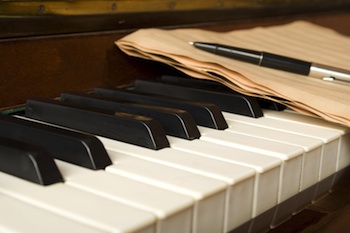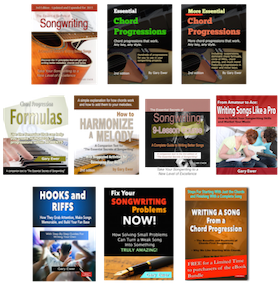Got a melody, but need chords? Here’s a quick 3-step process to adding chords to a melody.
____________________
Buy “The Essential Secrets of Songwriting” 10-eBook Deluxe Bundle, and increase the fan base for your music.
____________________
 Many songwriters find it easiest to play around with some chords, get them to sound good, and then create a melody that works. The problem with that method is that melodies can sometimes sound rambly and shapeless.
Many songwriters find it easiest to play around with some chords, get them to sound good, and then create a melody that works. The problem with that method is that melodies can sometimes sound rambly and shapeless.
Sometimes it can be better to create a melody first, and then add chords. But to do that you need to figure out the time signature, the key of your melody, and then determine how often you want chords to change.
Here’s a quick 3-step process for adding chords to a melody:
1. Determine the time signature and basic pulse of your melody. This is not as hard as you might think. Simply sing through your song, and tap your foot where it feels natural to do so. You’ll soon discover that some of the beats feel like strong ones, while others feel weaker. If your song feels like an alteration of one STRONG followed by one weak beat, your song is likely to be in 4/4 time — four beats for every bar. (That’s the most common time signature). If your song feels like an alteration of one STRONG followed by two weak beats (a waltz kind of feel), your song is in 3/4 time (like the song “Mull of Kintyre”).
2. Choose the key of your song. You’ll want to know a bit of theory for this, but basically you should sing through your song and see which notes you’re using. All music is transposable, but you will want to settle on a key to help choose chords. Often, songs will end on the tonic note, so you may want to use the final note of your song melody to help you discover the key.
3. Make chord choices based on the notes in your melody. How often you change chords is up to you, but you’ll want to settle on something regular, like every 2, 4 or 8 beats. If you’ve decided to change chords every two beats, take a quick look at the first two beats of your song. If your song mainly uses quarter notes (i.e., changes notes on every beat), find a chord that uses both of the first two notes. Keep in mind that your chord progressions should try to make they tonic note (i.e., the note representing the key) important. Keep chord choices simple at first.
That’s really all there is to it. It’s a relatively simple process of choosing chords that fit most of the notes of your beat groupings.
Don’t be afraid to experiment. Let your ears be your guide, and you should be able to tell if the chords are working with the melody.
_______________
Follow Gary on Twitter
 What do you use your iPad for? Learn all the essential secrets of songwriting, and take your songs to a new level of excellence. The 10-eBook Deluxe Bundle comes with this deal.
What do you use your iPad for? Learn all the essential secrets of songwriting, and take your songs to a new level of excellence. The 10-eBook Deluxe Bundle comes with this deal.








